Are you a Quiet Speculation member?
If not, now is a perfect time to join up! Our powerful tools, breaking-news analysis, and exclusive Discord channel will make sure you stay up to date and ahead of the curve.
This week marked some big news for Modern: Opt is finally entering our card pool. I've heard some decry the card as a worse Visions that will only see play in draw-go and tempo decks, and others still call Opt a change to our card pool nearly on par with Fatal Push's impact. For me, Opt's arrival means more deckbuilding options in the cantrip-heavy decks I favor when I'm not tapping Eldrazi Temple. Plenty has been written about casting Legacy-level cantrips like Brainstorm and Ponder, but precious few resources exist detailing the intricacies of Serum Visions or Sleight of Hand. Well, never fear—Captain Hooting Mandrills is here!
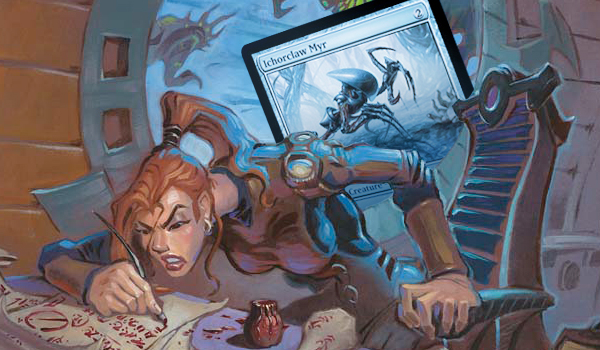
The Opt reprint has caused me to think hard about Modern's cantrips. This guide assesses where Opt will and won't see play over other options, in addition to providing format newcomers with a crash course on how they can draw a card.
Understanding Cantrips
Cantrips don't influence the board or interact with opponents. So why do people spend mana on them, especially in a format as brutally fast as Modern? Well, cantrips fundamentally affect and positively influence deck design. They also grant players more consistent games. Lastly, cantrips frequently offer additional benefits in decks that play them. Let's explore each of these notions in detail.
Deck Construction: The Turbo Xerox Rule
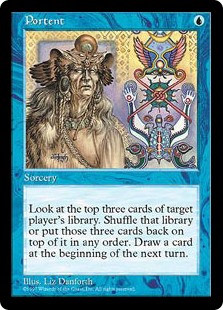
The Turbo Xerox Rule, named for the first true netdeck, states that for every two cheap cantrips in a deck, its land count can be reduced by one. I've got a lot of waxing about cantrips ahead of me, so let's have Patrick Chapin explain this one:
Alan Comer actually singlehandedly invented the concept of using cheap cantrips to fix your mana. In fact Turbo Xerox is the fundamental strategy that most blue Legacy decks are built on! What Comer realized was that even with just seventeen Islands and four Portents he had about an 85% chance of having two Islands by turn two on the play (almost 90% on the draw). This also doesn't take into consideration mulligans which easily pushed him into the mid-90s. [...]
If it sounds like this is a lot of work just to get three Islands by the third turn it is but it is not without a payoff. Once Comer made that initial investment to assemble three Islands by turn three he had a major advantage over every other deck he would face. People with 23 land in their deck draw land 38% of the time. Turbo Xerox draws a land just 28% of the time. This means that more than one out of four times that you would draw a land you don't need you instead draw a spell.
In-Game Allure: Improving Consistency and Velocity
Drawing fewer unneeded lands in the mid- and late-game is already a great payoff for including cantrips, but that payoff is mostly created and accounted for in the deckbuilding stage. Cantrips also provide in-game consistency by smoothing out draws. This consistency effect is the most tangible benefit of resolving cantrips and the first new players tend to grasp.
Taken to its logical extreme, the Turbo Xerox Rule can be applied to nonland cards, too. Cantrips greatly improve the chances of seeing a crucial one-of, such as Secure the Wastes in a highly reactive Weissman deck, in the right game window. Scry effects also allow pilots to tuck a Secure they see too early. With cantrips, sideboard cards are seen more frequently, as are the right cards for any given situation.
A less explicit form of consistency that cantrips provide is velocity, or the motion of cards between zones—specifically, from unknown zones to known zones. Cantrips move a card from the hand to the stack to the graveyard, while also moving one or more cards from the library to the hand or the graveyard. All that movement, especially combined with the hard consistency of card selection effects, works to enable powerful payoff cards. If card selection alone isn't worth the cost, the "negative tempo" of spending mana on cantrips is usually negated by the virtual mana gained from casting a 5/6 for two mana, which makes cantrips deceptively powerful even beyond their more obvious uses.
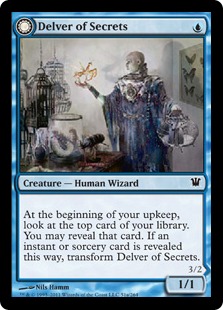 Icing on the Cake: Promoting Synergy
Icing on the Cake: Promoting Synergy
That's not all—in many decks, cantrips do even more than affect deckbuilding and provide consistency. Throw some creatures with prowess or delve into the mix and they become enablers for a uniquely aggressive strategy. Young Pyromancer and Monastery Swiftspear are creatures that slot effortlessly into cantrip-heavy decks; Delver of Secrets practically demands one. Snapcaster Mage, too, gets much stronger in a deck with cantrips, as pilots can rush it out proactively against do-nothing opponents and enjoy extra library manipulation and a card for their trouble.
Some cards still care about graveyard density, such as Bedlam Reveler or Tasigur, the Golden Fang. Others still benefit from a critical mass of cantrips in a deck, like Disrupting Shoal. When many of these elements come together, micro-synergy-laden aggro-control machines known as threshold decks take form.
"Draw a Card" in Modern
By now, you're sold on cantrips. The rest of this article compares the cantrips available in Modern. I've divided the covered cantrips into three categories, based on the type of advantage they're played for: immediate card selection, delayed card selection, and velocity.
I've omitted from this piece cantrips played for their "real" effect, such as Twisted Image and Peek, as well as cantrips that can "miss" like Oath of Nissa and Ancient Stirrings. Also absent are cantrips that cost two or more mana, like Anticipate and Nihil Spellbomb. While these cards are all technically cantrips, they're not cantrips in the Turbo Xerox sense of early-game fixing, mid-game smoothing, and late-game digging; the cards considered here deliberately provide selection or velocity.
Immediate Card Selection
Immediate card selection is the most powerful form of selection, and the cantrips played in eternal formats—Brainstorm, Ponder, and Preordain—all fall into this category. Modern's immediate selection cantrips are notably less powerful than those three, but far from unplayable.
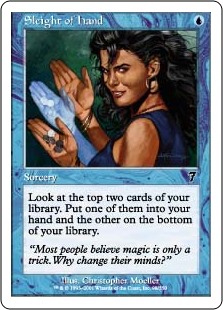 Sleight of Hand
Sleight of Hand
The go-to Serum Visions 5-8, Sleight of Hand usually sees play in combo decks, which need as much selection as they can get. It's also notably better than Serum Visions in decks like Storm, which gains little from delayed selection once it starts going off, and Ad Nauseam, which wants to find and suspend Lotus Bloom on turn one.
In terms of power, Sleight of Hand is a strictly worse Preordain; instead of choosing what to do with the two "scried" cards, casters are forced to top one and bottom the other before drawing. It's so much worse (Serum Visions rests between them on the power scale) because Preordain gives players so many options---they can top top and draw, top bottom and draw, or bottom bottom and draw. That's also why Ponder is leagues ahead of Preordain in a format with fetchlands. With a fetch in play, Ponder casters can choose to take only the first card, the first and the second, all three, or another card altogether, and all while seeing three cards before deciding which come to the hand. Brainstorm operates similarly, although since it also tucks cards from the hand, it gives casters even more options than the already busted Ponder. These two cantrips are blue-chip staples in Legacy and restricted in Vintage for the wealth of options they supply, and Sleight of Hand doesn't offer much in the way of choice.
Most Serum Visions decks don't play Sleight of Hand. The card's effect is simply so small that many decks don't want to spend a mana on it. Many reactive decks, like UW Control, play Serum Visions to help set up their early draws. Sleight is significantly worse at setting up early draws, since it doesn't see as many cards.
Decks with both Serum Visions and Sleight of Hand have cantrip sequencing to worry about. Casting Serum first and then Sleight is ideal for finding an immediate answer, since it sees up to five new cards and ensures the one we want is drawn if among them. Casting Sleight, then Serum also sees a total of five cards, but the last two won't be accessible this turn; that's fine and even preferable if we're out of mana anyway or already have something else to do with our mana this turn cycle, as it smooths out our draws for longer and hides cards from hand disruption. I'm looking forward to seeing how Opt influences cantrip sequencing in decks that run Opt and one or two other cantrips.
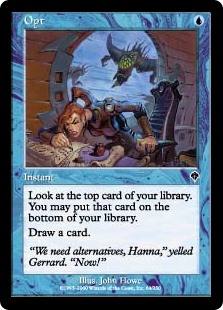 Opt
Opt
I've heard people call Opt a "strictly better Sleight of Hand." That it is not. In a topdeck war scenario, Sleight of Hand is the better cantrip to draw. If Sleight reveals two cards of similar relevance, players can choose the better card for the situation. By contrast, if Opt reveals a card less impactful than the majority of the other cards in the deck, players are correct to bottom that card and draw a fresh one. But there's a chance that second card is even worse.
Notably, the same doesn't hold true for good cards: if players take the card they scry, but the next card is even better, they still get to draw that better card next turn (barring something like a fetchland activation). Even a Sleight that reveals two bad cards is productive, since those cards won't have to be drawn for turn; a Sleight that reveals two good cards, though, can be painful, since one will be lost. Either way, pilots draw a good card, and since the point of immediate selection is, well, immediate selection, Sleight trumps Opt in this kind of game state.
It also trumps Opt in the early stages of the game, when players need to make their land drops. Imagine keeping a one-lander in Counter-Cat (to follow this example, click on this link and glance over the decklist), fetching up a Steam Vents, and leading with Delver. Next turn, we draw a nonland card and cast Opt. If Opt reveals Island, we're likely to scry top, draw it, and play it. But what if the next card is a fetch? We often don't want a third land drop in this deck until turn four or five, so we'd rather have put the Island on the bottom and drawn the fetch right away to cast  Wild Nacatl. Sleight of Hand allows us to do that. And if both cards are nonlands, the result is the same regardless of whether we have Opt or Sleight—in fact, Sleight ensures we get the best of those two cards despite them both being nonland cards, whereas Opt guarantees we get the second nonland card, which may be worse than the first.
Wild Nacatl. Sleight of Hand allows us to do that. And if both cards are nonlands, the result is the same regardless of whether we have Opt or Sleight—in fact, Sleight ensures we get the best of those two cards despite them both being nonland cards, whereas Opt guarantees we get the second nonland card, which may be worse than the first.
All that to say I don't see Opt totally replacing Sleight in decks that play the latter. But I do see Opt slotting into decks that don't run Sleight of Hand. The main reason is its typing: instant speed is a huge deal for certain decks, especially draw-go ones. Even the mighty Serum Visions has a palpable tension in the Jeskai Tempo lists we've been seeing pop up, which has plays at every turn of the game—Helix turn two, Queller turn three, Command turn four. Casting one-mana sorceries throws a wrench into that curve, forcing players to take a turn off of representing their spell. Opt can come down on the end step when opponents smugly pass the turn without making a move, providing selection and velocity virtually for free.
In this sense, I think Opt is much closer to Think Twice than it is to Sleight of Hand. But it's possible threshold-style decks like Grixis Shadow will end up wanting it, too. It will be fascinating to see which decks adopt Opt as Modern evolves post-Ixalan, and to observe the effects this card has on deckbuilding.
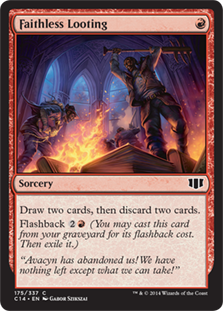 Faithless Looting
Faithless Looting
Faithless Looting is more of an honorable mention in this list, since it's a -1. The other cards here all replace themselves. To compensate, Looting provides Modern with a pseudo-Brainstorm, helping fix hands that already have bad cards in them. A deck with Looting is a deck that can sit on extra lands without playing them with the knowledge that a "Draw 4 cards" effect exists in the deck somewhere.
The decks that play Looting, though, benefit from its drawback. Hollow One, Vengevine, Stinkweed Imp, and Griselbrand all adore this card, which proactively advances graveyard-based gameplans while providing the many aforementioned benefits of cantrips. Modern is the most card-advantage-centric it's been in a good while, but the more tempo-centric the format pendulum swings, the better Looting will be—and the higher the chances of it showing up in non-graveyard decks.
Delayed Card Selection
While delayed selection is worse than immediate selection, the best cantrip in Modern happens to belong to the former group. The best cantrips in the game elude our legal card pool, and Serum Visions happens to reign supreme among those that remain.
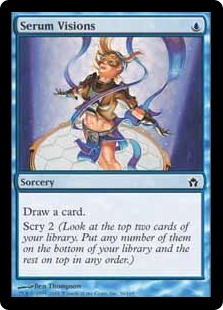 Serum Visions
Serum Visions
This oft-reviled cantrip was once ritualistically omitted from Jeskai Control lists because of its damning sorcery typing. Not anymore! Modern has come around on the power of Serum Visions, even if some guys at your FNM keep telling you how bad it is because they've recently played some Legacy. Visions is hard selection that looks further than any other card in the format for its cost.
Serum Visions is uniquely excellent at setting up future turns. When players don't have much mana handy, Visions can even be better than Preordain. It sees the same amount of cards, but the sequencing of its effects hides juicy targets from Inquisition of Kozilek or Thought-Knot Seer. Visions is also a great cantrip to chain, since the second Visions will draw the card found with the first.
Perhaps the biggest strike against Serum Visions is its interaction with fetchlands. Setting up future turns is obviously powerful, but the scry is lost if players crack a fetch. This interaction forces players to fetch in suboptimal ways, sometimes taking damage from untapped shock lands before casting the cantrip and then never spending the mana. But we've all fetched a tapped land and then found a one-drop with Serum's blind draw. I think this factor makes Serum Visions a difficult cantrip to resolve correctly, as its resolution incorporates many aspects of the game state, including life totals, remaining deck contents, and bluffing.
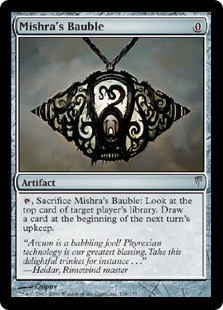 Mishra's Bauble
Mishra's Bauble
Mishra's Bauble doesn't provide any selection on its own, but given Modern's high volume of fetchlands, it often reads "0: Scry 1, then draw a card at the beginning of the next turn's upkeep." That "next turn's upkeep" clause makes Bauble a very interesting cantrip to play. Finding removal with it during the main phase ensures pilots have that removal spell on their opponent's next turn, and Bauble can be used to manipulate the library around upkeep triggers like that of Delver of Secrets to gain extra peeks.
Granted, the conditional selection Bauble provides is minute, as it should be for a zero-cost spell. Rather, Bauble is usually played for velocity reasons, as well as for its phenomenal typing; being an artifact, Bauble triggers prowess, grows Tarmogoyf, and enables delirium and metalcraft in addition to providing marginal selection and replacing itself. Talk about role play!
I almost included Bauble in the velocity section below, but it does provide delayed card selection. Consider it a straddler of the selection-velocity cantrip fence.
Velocity
Velocity cantrips don't provide any card selection, instead focusing on moving cards between zones. They're often on the cheaper side, costing one or zero mana while many of Modern's selection cards cost two. They're also frequently niche.
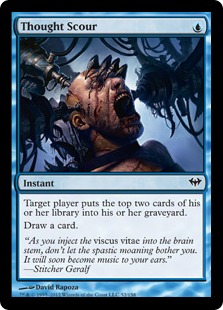 Thought Scour
Thought Scour
Thought Scour is the only velocity cantrip to actually cost mana. But its cost is well-deserved, as it dumps a whopping three cards into the graveyard, including two new ones from the deck, and immediately replaces itself. That's a lot of juice for Snapcaster Mage, Grim Lavamancer, Gurmag Angler, or what have you—three cards is the same amount we see with Serum Visions! Of course, Scour offers no control over which card makes it to the hand. But that's not the point. Decks that toolbox out of the graveyard, or can interact with the graveyard in some way, love Thought Scour; it's much easier to squeeze value out of cards in the bin than out of ones in the deck, after all.
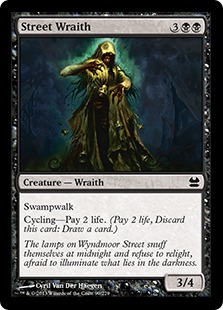
Street Wraith
Like Mishra's Bauble, Street Wraith draws a card for no mana. Instead of providing a little selection and wonky artifact synergies, Wraith costs life and draws the card right away, while enabling some synergies of its own. Death's Shadow turns the life point cost into a benefit and uses Wraith to fuel delve and super-power Serum Visions; Living End reanimates Wraith as part of its primary game plan while using it to dig into its namesake card; Hollow One cares specifically about the word "discard."
Wraith's two-life cost makes it a tough sell in other decks thanks to the format's aggro decks, especially Burn. That's despite its apparent floor as a split card that's one side cantrip, one side 3/4 swampwalker. Modern is too fast for that second side to matter much, so, like Bauble, Wraith finds itself relegated to decks that can abuse it in multiple ways.
Can't R.I.P.
That's right, no peaceful rest for the weary—or rather, for those of us obsessed enough with cantripping to tirelessly test Opt in different shells until Ixalan drops. One thing's for sure, though: despite our inevitable fatigue, we won't be the ones who can't rip the right answer!




I think the comment about Opt’s typing hit the nail on the head. You already mentioned Jeskai Tempo (which will swap Serum Visions for it in a snap and potentially run a 60 where every nonland card can be cast at instant speed), but I think even Grixis Shadow players will experiment with it. While Shadow doesn’t mind tapping out in the early game, being able to hold up 3 mana having everything from Fatal Push/Opt/Thought Scour to Terminate to Kolaghan’s Command to Snap-Fatal Push/Opt/Thought Scour available sounds downright delicious.
Agree. I think Jeskai decks stand to gain the most from Opt’s arrival, and it’s not even close.
I don’t know if the selection is enough in Shadow. That deck heavily relies on Serum to fix its openers, so that card isn’t going anywhere. But Ari Lax has popularized a build with Sleight of Hand and 17 lands, so Opt may find its way into that build.
The problem with Opt there is that Shadow doesn’t usually want to represent cards on the opponent’s turn. If it’s going to cast Kolaghan’s, it’s going to cast Kolaghan’s. Denial only costs one mana and Sleight is better at finding one immediately. Sleight’s also better at sculpting openers, as described in the article. Basically, if you’re going to be casting your cantrips at sorcery speed a good deal of the time anyway, Sleight is superior. I think Shadow falls into that boat more often than not. Opt will mainly be better in game states where they’re stuck on two lands, but again, Sleight is better at fixing those game states by finding that crucial third land.
Honestly, one effect of Opt coming to Modern might be that a bunch of players try to jam it, realize it’s worse than Sleight in multiple shells, and then come around to running Sleight when they weren’t before. I’ve always said the card is underrated, and Opt might be the instigator it needs to be taken seriously.
Something else that about Opt being printed that I’m currently working on is what happens to Preordain’s chances of being unbanned.
In line with their diversity goals, Wizards prefers when multiple spells battle for the same deck slots. The Push printing was a wild success on this front. Sleight, Opt, Serum all fight for card selection slots.
Releasing Preordain goes against this card diversity goal by invalidating all three in decks with only four slots to spare. It’s strictly better than Sleight and Opt and better than Serum in almost every scenario, since it’s the same card but with immediate selection rather than delayed.
That’s not to mention the potential power/color/archetype imbalances Preordain might cause. Right now Modern is plenty healthy and diverse, another reason I doubt Wizards unbans such a powerful card—they probably don’t want to mess up a good thing, and are likely to be more cautious about format health after the last Standard season.
All potentially true, but that’s not what I was referencing. Opt is Preordain adjusted to instant speed, and Wizards is leery of too many cantrips boosting combo. This probably shuts the door on Preordain ever coming off the banlist, regardless of what my data may or may not say.
Hey Jordan – a while back (just before the banning of Gitaxian Probe) there was a deck making waves and picking up steam called ‘Thing Ascension’. namely Thing in the Ice, Pyromancer Ascension and a whole pile of burn and cantrips.
Since the reprinting of Opt it occurred to me that this deck may yet have some life in it still. My feeling is that in order to protect its namesake threats, one can employ a playset of [[Disrupting Shoal]] in the same way that Infect is currently doing, to claw back into the metagame. shoal pitching a cantrip counters 90% of the removal you’d see in your average modern tournament, and pitching a second shoal or a Thing counters many of the most dangerous two-drops that might be played (such as Chalice of the Void).
I like the idea. it actually seems very good in the current meta.
Good call. The jury’s still out about Storm, but UR Thing definitely wants a critical mass of cantrips. And agree that Shoal works well there. Worth looking into!